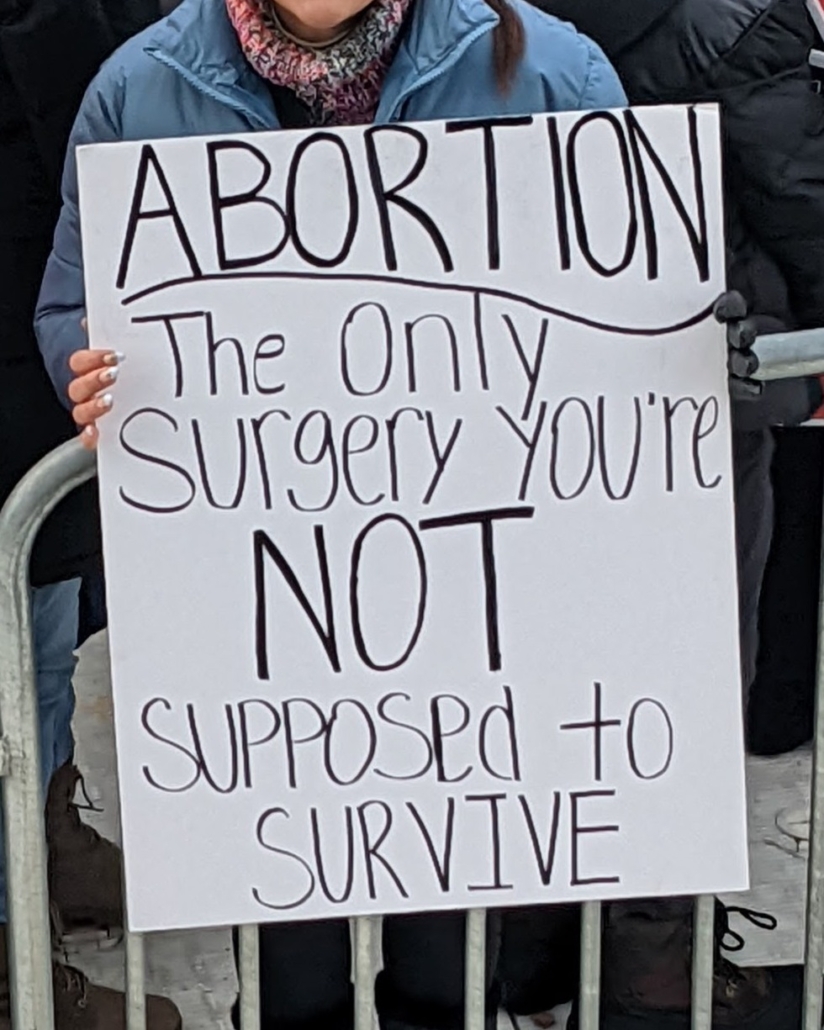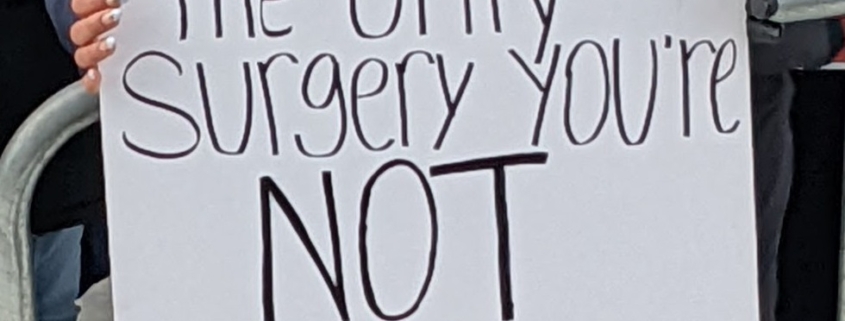Abortion isn’t just about ending a pregnancy; it’s about killing a fetus.
Some pro-choice people claim that abortion is only about ending a pregnancy.
The argument goes something like this: The fundamental premise of the pro-choice position is that no person has the right to use your body against your will. An embryo or fetus is using a woman’s body to survive – and not only using her uterus but also affecting every body system she has. If the woman doesn’t want to give of her body that way, she has the right to refuse and thus to end the pregnancy. If she ends the pregnancy before viability, the fetus will die, yes. But if she ends the pregnancy after viability, the fetus will be born prematurely and (possibly) survive. Whether the fetus lives or dies is not the point; the point is that abortion allows women a mechanism to refuse to let embryos or fetuses use our bodies against our will.
This is the theory, anyway. But it’s not the reality.

Artificial wombs are a threat to abortion rights.
If abortion were just about ending a pregnancy, abortion activists would view ectogenesis (gestation in artificial wombs) as a theoretical solution to the problem of unwanted pregnancy: the woman can still end the pregnancy, thus refusing the use of her body, but the fetus doesn’t have to die in the process.
But abortion activists reject this (eventual) possibility.
Christine Henneberg, Boston Review
Writing about performing abortions after fetal viability, abortion provider Christine Henneberg is unequivocal (emphasis added):
Viability is a moving target. In 1973, at the time of Roe, neonatal life-support technology could sustain a premature baby born around or after twenty-eight weeks of gestation. Since then, improvements in medical technology have moved that point to twenty-four weeks or even slightly earlier, depending on the hospital’s equipment and the experience of its neonatologists. If neonatal resuscitative technology continues to improve, to the point that we can sustain a baby born at twenty or sixteen weeks—then what? Such advances would certainly benefit women with desired pregnancies who give birth to extremely premature babies, babies whose lives they—and we—would wish to save. But what if a five-week embryo, removed from a woman’s body, could be placed in an incubator, sustained, and coaxed to life as a fully formed human being? Then “viability” would come to mean essentially the same thing as the fetal “heartbeat”—the vaguest, most primitive sign of cellular potential, which can be used to draw some supposedly logical, biological, or ethical line around the fetus, to delineate its rights and keep the rest of us morally comfortable.
This is the real problem with the “protection” of viability—the reason why Sandra Day O’Connor denounced the Roe framework as “clearly on a collision course with itself”: it leaves the woman with nothing. It gives the fetus (or the state supposedly representing its interests) all the protection and all the power.
Christine Henneberg, “Why I Provide Abortions,” Boston Review
Claire Horn, Medical Law Review
In her article Abortion Rights after Artificial Wombs: Why Decriminalisation is Needed Ahead of Ectogenesis, Claire Horn echoes similar concerns (emphasis added):
Significant scientific progress has been made toward artificial womb technology, which would allow part of human gestation to occur outside the body. Bioethical and legal scholars have argued that artificial wombs will challenge defences of abortion based in arguments for protecting bodily autonomy, for a pregnant person could have the foetus transferred to an artificial womb instead of being terminated. Drawing on examples from the common law jurisdictions of Canada, the USA, and the UK, I assess three ways scholars have argued abortion might be defended after ectogenesis (through redefining foetal viability, through a property right, and through a right to avoid genetic parenthood). I argue that while each of these proposals has strategic merit, each has significant legal and ethical limitations. Taking the normative position that abortion will remain a vital healthcare resource, I make the case for protecting abortion rights from a challenge posed by ectogenesis by focusing on decriminalisation.
Claire Horn, “Abortion Rights after Artificial Wombs: Why Decriminalisation is Needed Ahead of Ectogenesis”
Rosalind Moran & Jolie Zhou, Wired
In the Wired article “Artificial Wombs Will Change Abortion Rights Forever,” the authors are even more candid (emphasis added):
Though ectogenesis would make it possible to avoid pregnancy without ending the fetus’s life, such an outcome is not necessarily a positive from a feminist point of view. The reality is that some women who choose abortion do so not only to end the pregnancy—preserving bodily autonomy—but also to avoid becoming a biological mother. Ectogenesis would still make her a biological mother against her will, and using it as an alternative to traditional abortion could therefore violate her reproductive autonomy.
Rosalind Moran & Jolie Zhou, “Artificial Wombs Will Change Abortion Rights Forever”
Vardit Ravitsky, NPR
In An artificial womb could build a bridge to health for premature babies, author Rob Stein quotes Vardit Ravitsky, the CEO of the bioethics think tank The Hastings Center, regarding artificial womb technology (emphasis added):
I am absolutely pro the technology because I think it has great potential to save babies … My concern is that pregnant people will be forced to allow fetuses to be taken out of their bodies and put into an artificial womb rather than being allowed to terminate their pregnancies — basically, a new way of taking away abortion rights.
Vardit Ravitsky, “An artificial womb could build a bridge to health for premature babies”
Joona Räsänen, Bioethics
In Ectogenesis, abortion and a right to the death of the fetus, Joona Räsänen is as direct as possible (emphasis added):
I argue that there is a right to the death of the fetus because gestating a fetus in an artificial womb when genetic parents refuse it violates their rights not to become a biological parent, their rights to genetic privacy and their property rights.
Joona Räsänen, “Ectogenesis, abortion and a right to the death of the fetus”
Abortion providers induce fetal demise before removing viable fetuses.
We don’t need scifi thought experiments to see that abortion is not just about ending a pregnancy. That reality is clear already with the existence (and legality) of abortion procedures that end the lives of otherwise healthy, viable fetuses.
[Read more – Evidence that later abortions are not all for medical emergencies]
If abortion were just about ending a pregnancy, abortion activists would view with horror procedures that purposefully end the lives of viable, healthy fetuses. Like the rest of us, they would argue such killing is anathema and totally unnecessary. “Abortion” after viability would be only induction of labor, in a hospital, with the intent of live birth and the baby transferred to a NICU. But it’s not.
Christine Henneberg, Boston Review
Christine Henneberg again doesn’t mince words:
If a woman decides to proceed with an abortion after twenty-four weeks, she must accept the terms: that she will deliver a baby, and that baby will be dead.
Christine Henneberg, “Why I Provide Abortions,” Boston Review
Isabelle Schiff, Reproductive Sciences
Abortion providers who perform abortions near or after viability make sure to “induce fetal demise” (kill the fetus) prior to removing him or her from the woman’s body. Many providers do this by injecting a feticide into the fetal heart or amniotic fluid. Some do it by transecting the umbilical cord and waiting for the fetus to die before removal. But however they do it, they make sure the fetus is dead, even and especially if the fetus may have otherwise survived the birth. A recent paper out of the UK (“Feticide Before Termination of Pregnancy in Singleton Pregnancy“) described this explicitly:
In these cases [viable pregnancies without fetal abnormality] feticide may be essential to prevent a live birth and the potential survival of an extremely premature baby, which would defeat the purpose of the termination.
Isabelle Schiff et al
Diane Horvath, New Yorker
A New Yorker article profiling an all trimester abortion clinic in Maryland describes a woman aborting at 32 weeks because she didn’t learn she was pregnant until 30 weeks. The article quotes presiding OBGYN Diane Horvath:
We induce demise. This idea that people are delivering live fetuses—it just does not happen.
Diane Horvath, “A Safe Haven for Late Abortion,” New Yorker
Society of Family Planning, Contraception
Clinical recommendations regarding how to “induce fetal asystole” (stopping the fetal heart) for later abortions:
At periviable gestations and after fetal viability, inducing fetal asystole before abortion prevents the infrequent but serious occurrence of unanticipated expulsion of a fetus with cardiorespiratory activity.
Diedrich et al, “Society of Family Planning Clinical Recommendation: Induction of fetal asystole before abortion Jointly developed with the Society for Maternal-Fetal Medicine”
Bodily rights are not the core issue.
Abortion activists use the language of bodily rights to justify abortion, but bodily rights are largely a diverson.
Philosophically, bodily rights don’t come close to justifying elective abortion (more here). Legally, Roe v. Wade had specifically rejected bodily rights as justification for abortion (more here). And practically, bodily rights aren’t the main reason women abort (more here).
The abortion debate is truly a debate about fetal value. Generally, the pro-life side believes fetuses are valuable human beings with the right to not be unjustly killed–even though they need their mothers’ bodies to survive. And–again, generally–the pro-choice side views fetuses as something less than valuable human beings and therefore permissible to kill–sometimes even if they don’t need their mothers’ bodies to survive.
If you appreciate our work and would like to help, one of the most effective ways to do so is to become a monthly donor. You can also give a one time donation here or volunteer with us here.


